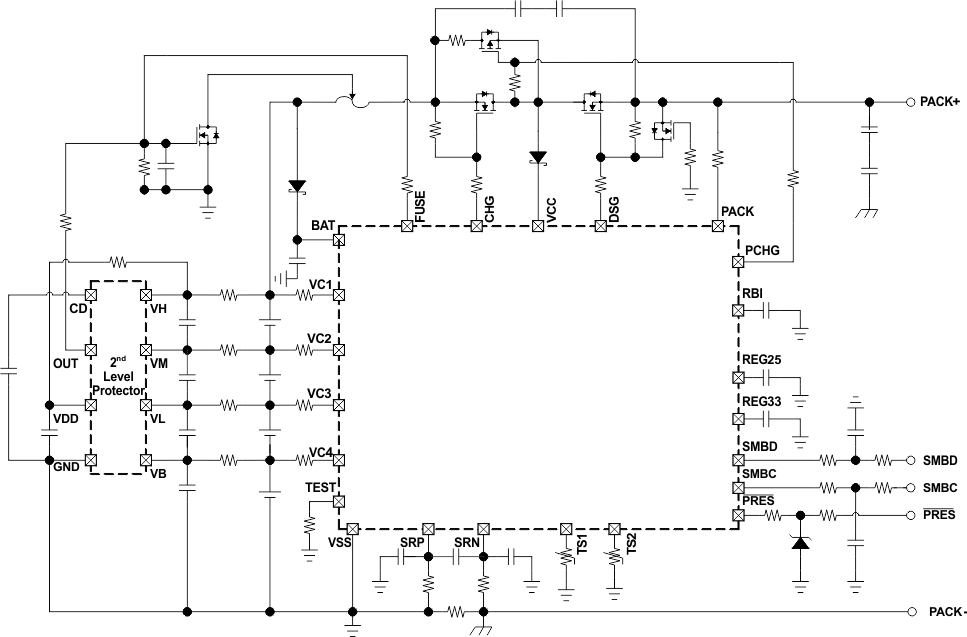SLUSA91C October 2010 – October 2015
PRODUCTION DATA.
- 1 Features
- 2 Applications
- 3 Description
- 4 Revision History
- 5 Pin Configuration and Functions
-
6 Specifications
- 6.1 Absolute Maximum Ratings
- 6.2 ESD Ratings
- 6.3 Recommended Operating Conditions
- 6.4 Thermal Information
- 6.5 Electrical Characteristics: Supply Current
- 6.6 Power-On Reset (POR)
- 6.7 Wake From Sleep
- 6.8 RBI RAM Backup
- 6.9 3.3-V Regulator
- 6.10 2.5-V Regulator
- 6.11 PRES, SMBD, SMBC
- 6.12 CHG, DSG FET Drive
- 6.13 PCHG FET Drive
- 6.14 FUSE
- 6.15 Coulomb Counter
- 6.16 VC1, VC2, VC3, VC4
- 6.17 TS1, TS2
- 6.18 Internal Temperature Sensor
- 6.19 Internal Thermal Shutdown
- 6.20 High-Frequency Oscillator
- 6.21 Low-Frequency Oscillator
- 6.22 Internal Voltage Reference
- 6.23 Flash
- 6.24 OCD Current Protection
- 6.25 SCD1 Current Protection
- 6.26 SCD2 Current Protection
- 6.27 SCC Current Protection
- 6.28 SBS Timing Requirements
- 6.29 Typical Characteristics
- 7 Parameter Measurement Information
- 8 Detailed Description
- 9 Application and Implementation
- 10Power Supply Recommendations
- 11Layout
- 12Device and Documentation Support
- 13Mechanical, Packaging, and Orderable Information
Package Options
Mechanical Data (Package|Pins)
- DBT|30
Thermal pad, mechanical data (Package|Pins)
Orderable Information
1 Features
- Fully Integrated 2-Series, 3-Series, and 4-Series Li-Ion or Li-Polymer Cell Battery Pack Manager and Protection
- Advanced Compensated End-of-Discharge Voltage (CEDV) Gauging
- High-Side N-CH Protection FET Drive
- Integrated Cell Balancing
- Low-Power Modes
- Low Power: < 180 µA
- Sleep < 76 µA
- Full Array of Programmable Protection Features
- Voltage
- Current
- Temperature
- Sophisticated Charge Algorithms
- JEITA
- Enhanced Charging
- Adaptive Charging
- Supports Two-Wire SMBus v1.1 Interface
- SHA-1 Authentication
- Compact Package: 30-Lead TSSOP
2 Applications
- Notebook and Netbook PCs
- Medical and Test Equipment
- Portable Instrumentation
3 Description
The bq3055 device is a fully integrated, single-chip, pack-based solution that provides a rich array of features for gas gauging, protection, and authentication for 2-series, 3-series, and 4-series cell Li-Ion and Li-Polymer battery packs.
Using its integrated high-performance analog peripherals, the bq3055 device measures and maintains an accurate record of available capacity, voltage, current, temperature, and other critical parameters in Li-Ion or Li-Polymer batteries, and reports this information to the system host controller over an SMBus v1.1 compatible interface.
The bq3055 provides software-based 1st-level and 2nd-level safety protection for overvoltage, undervoltage, overtemperature, and overcharge conditions, as well as hardware-based protection for overcurrent in discharge and short circuit in charge and discharge conditions.
SHA-1 authentication with secure memory for authentication keys enables identification of genuine battery packs beyond any doubt.
The compact 30-lead TSSOP package minimizes solution cost and size for smart batteries while providing maximum functionality and safety for battery gauging applications.
Device Information(1)
| PART NUMBER | PACKAGE | BODY SIZE (NOM) |
|---|---|---|
| bq3055 | TSSOP (30) | 7.80 mm × 4.40 mm |
- For all available packages, see the orderable addendum at the end of the data sheet.
Simplified Schematic
